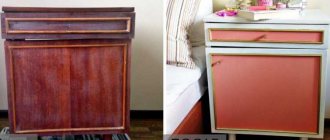An easy way to paint furniture in Provence style with your own hands
Do-it-yourself Provence style furniture allows you to make your home truly cozy and fill it with a unique atmosphere of rustic romance. The French provincial style, characterized by an organic combination of naturalness and grace, has gained particular popularity recently. This is understandable, because its indisputable advantages include environmental friendliness and soft, eye-pleasing pastel colors.
Decorating a room in the Provence style will not require large financial expenditures. It is enough to restore old grandmother’s wardrobes and chests of drawers, as well as purchase a few intricate interior items at the flea market. Even a person without special training can decorate furniture in a French country style. We will tell you how to do this in this master class.
Varieties
In the collections of connoisseurs, as well as in high-status salons, you can find antique furniture in any variety.
Upholstered furniture sets:
- Sofas with poufs for boudoir, upholstered in silk or antique tapestry;
- Luxurious genuine leather chairs that stood in offices and libraries;
- Couches, small sofas with soft chairs for the dining room or living room and much more.
Cabinet furniture:
- Buffets made of solid oak, beech or other valuable woods;
- Dining tables with polished top and sliding mechanism. Round and oval versions were often used, rectangular ones were preferred for large banquet halls;
- Wardrobes, chests of drawers, beds with carved elements are the attributes of a luxurious bedroom. Chests for storing wardrobes were placed in the same room;
- Dressing tables are another attribute of a bedroom or boudoir;
- Bookcases from floor to ceiling, with shelves and secret niches;
- Tables for offices are two-pedestal luxury items, decorated with carvings, inlays and inserts made of precious wood.
Not all antique furniture has to be luxurious. Designers also value rough products that reflect the life of ordinary people of different eras. Rough benches, log tables, chests of drawers and sideboards are widely used in modern interiors.
Armchairs
Sofa
Buffets
Table
Closet
Dresser
Couches
Brushing
Brushing is a labor-intensive and complex method of “aging” furniture. Used in combination with staining, painting and varnishing.
For work, prepare a grinder, chisels, sandpaper, and a set of hard metal brushes.
- Use a wire brush to comb out the soft wood fibers, moisten them with water to avoid dust and dry.
- Remove debris and crumbs.
- Use a chisel or drill to leave traces of wormholes in some places.
- Polish with a sisal roller.
- Apply wax or oil.
A special composition, which includes varnish and powdered pigment, will create gray or golden shades, giving the product an “aged” darkened appearance. A thick layer of stain and immediate removal of excess with a sponge will help to achieve a contrasting pattern. A sander and fine-grained emery will add abrasions.
More: Lifehacks for a small kitchen
The method is suitable for wood where growth rings are strongly pronounced: pine and oak, larch, ash and walnut.
Furniture made from teak, maple, beech, birch, alder and fruit trees is not suitable.
Craquelure on furniture
Craquelure is artificial cracks on the surface using a special cracking craquelure varnish.
The antique effect is created when the underlying thin layer of dark base paint is visible through the cracks. To do this, the surfaces are cleaned, washed if necessary, dried and primed, then painted and allowed to dry.
Afterwards, a contrasting, matte light paint is applied, and then a thick layer of varnish. If desired, sand some areas with soft sandpaper. The finished product is coated with furniture varnish.
More: How and with what to repaint furniture yourself
Decoupage furniture in Provence style
Decoupage
is a decorative technique popular throughout the world that appeared in Europe several centuries ago. It involves gluing pictures cut out of paper onto the surface to be decorated. This helps to style things into different styles or restore them.
Decoupage furniture is a great way to refresh your interior, breathing new life into familiar things. Using this technique you can create a completely unique decor. It doesn’t require a huge amount of finance, nor does it require professional skills. At home, it is quite possible to turn an old chest of drawers or any other piece of furniture into an exclusive antique product.
Provence
- popular French style. It is based on natural and relaxed, romantic and light motifs. The room, decorated in Provence, has spaciousness, light warm shades, original paintings, floral prints, and rural landscapes.
Is it necessary to contact designers? Decoupage of furniture with napkins or other methods can be easily done with your own hands by watching educational videos or photo master classes. You can see examples of furniture decor in the Provence style in this article.
For what styles is this technique used?
The interior with antique furniture is decorated with extreme care. If you enter an item incorrectly, you can ruin the entire design. This type of room decoration is used only in historical styles, such as country, chalet, Provence, vintage, shabby chic and in some cases classic, hi-tech and minimalism.
During the arrangement you can use several rules:
- Classic style looks better when using furniture made of valuable wood (oak, ash). A suitable technique is patination. Patination produces a matte surface that looks great in a classic-style interior.
- High-tech and minimalism, although more modern styles, also use aged furniture. Large echoes of antiquity are not used, but only small and almost invisible ones that complement the room and give it elegance. Dark shades are preferred.
Pay attention to the little things!
You can age furniture with your own hands very simply and do not require any special skills. The main thing is to follow all the steps of the process and follow safety precautions.
How to age furniture yourself
Artificially aged furniture also looks very beautiful and noble, but it is much easier, faster and cheaper to obtain than genuine antique furniture.
Of the existing methods of artificial aging of wooden surfaces, available for independent development, three main ones can be distinguished:
- Chemical. This method involves the use of various substances, such as ammonia, stain, craquelure varnishes, etc.
- Thermal. The effect of antiquity is achieved by exposure to a hot soldering iron or open fire.
- Mechanical. The most common method of causing damage is scratches, cracks, etc., and their subsequent treatment with varnish or paint to enhance the effect.
When using these methods, the result is completely different-looking aged furniture. Photos of each of the options are not comparable with each other, although all are considered manifestations of the same trend in the art of decoration.
Next, you can consider each of them in more detail, but before that it is necessary to prepare the surfaces to be treated, i.e. remove doors, fittings and decorative items from their hinges, as well as a layer of old paint or varnish.











